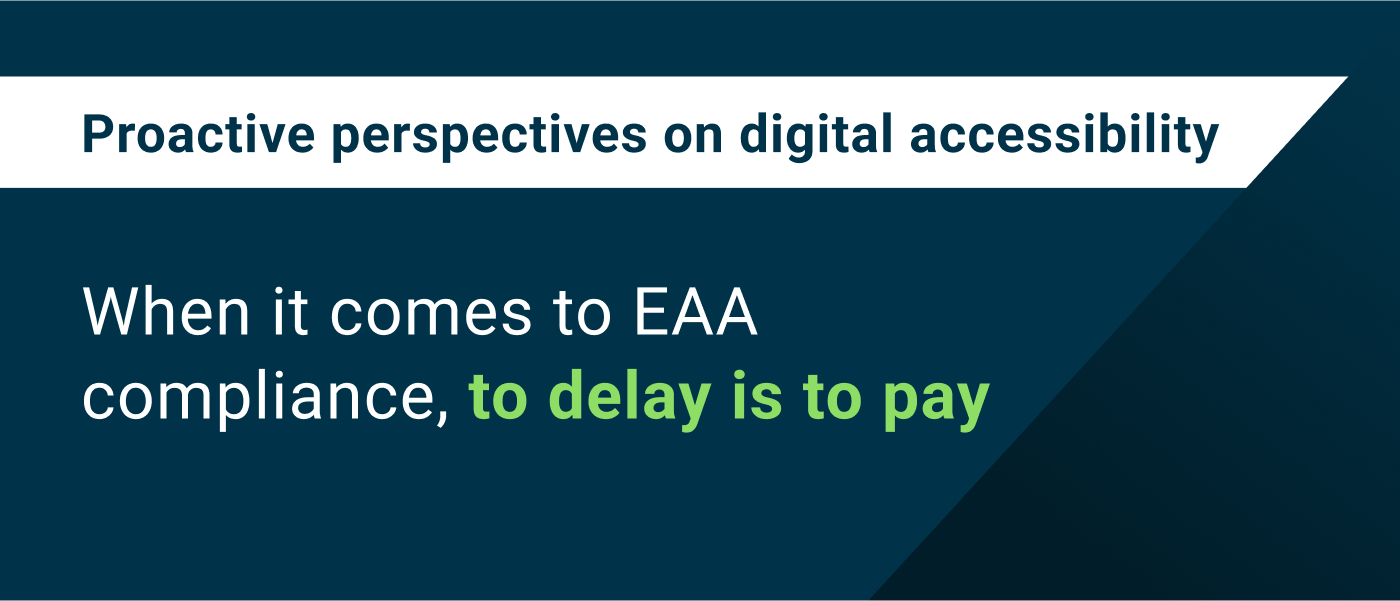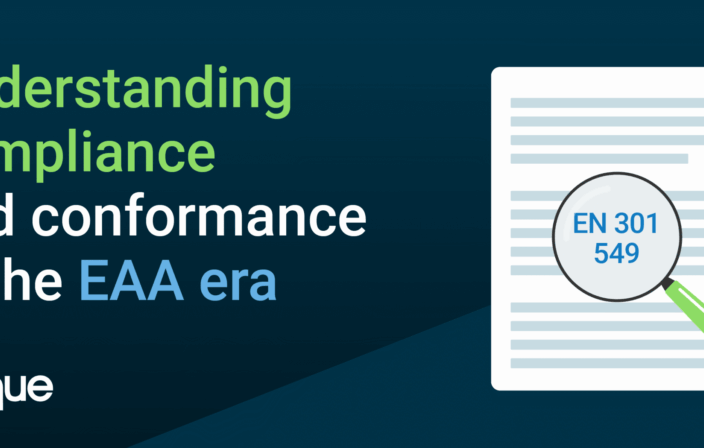In some ways, I just want to make this a very short post. If I did, it would read something like this:
The European Accessibility Act (EAA) becomes national law in all 27 European Union (EU) member states on June 28, 2025. If you do business in the EU and you don’t have a sustainable digital accessibility program in place by the deadline, you risk enormous fines, service suspensions, and further legal action. If you’re not 100% certain whether or how the EAA applies to your business, don’t wait. The stakes are too high. Get expert guidance, put a plan in place, and make the deadline. Because you’re ultimately choosing between investing a reasonable amount to get compliant now or paying an enormous amount later because you delayed.
That’s not going to be my whole post, however, because I don’t want to just scare you. Instead, I want to help you. And the good news is, Deque can help. But before we get into how, let’s take a step back and try to fully understand the situation.
If you’re currently doing business in any European Union countries and utilizing any digital channels or materials, you’ve almost certainly heard about the European Accessibility Act (EAA). You’re also hopefully aware of the first compliance deadline, which is June 28, 2025. It’s a real milestone, as this legislation will become national law in all 27 EU member states.
While the deadline may be clear, however, what exactly will be required of your business may be harder to understand. If that’s the case for you, that’s ok. You’re not alone.
As with any new laws and regulations, there are inevitably ambiguities, misinterpretations, and gray areas. That’s certainly been the case with many digital accessibility laws and regulations established in recent years.
It’s also very common for organizations to wait until close to the deadline before taking action. Sometimes that’s intentional. A business may want to see if any of those gray areas are resolved before they commit to a plan. It may also just be a natural resistance to change or the result of slow-moving internal processes.
With the EAA, one of the most significant areas where businesses desperately need additional clarity is understanding the impact if they are not based in the EU but do business there.
For example, I’ve been talking with many North American organizations that have been practicing accessibility for some time and are already in compliance with legislation such as the Americans with Disabilities Act (ADA) or the Accessibility for Ontarians with Disabilities Act (AODA). What these organizations are currently trying to determine is how to effectively bridge the gaps between what they’re doing for North America and what they’ll need to do for the EU, particularly for content that is utilized in both regions. Fortunately, Deque has already done a lot of work to simplify this mapping for our customers.
However, there is another pressing issue that needs to be addressed!
In many cases, I’m hearing from organizations that they consider themselves out-of-scope for EAA based on initial guidance they’ve received from their legal teams. In other words, they’re operating under the assumption that EAA does not apply to them. However, as I take an in-depth look into these situations, what I’m seeing is that they clearly are in scope—their legal guidance was either incomplete or inaccurate.
This is concerning. Mistakenly ruling your business out of scope for EAA could lead to serious legal and financial consequences, not to mention operational chaos, as teams are left with an insufficient ramp to build the processes needed to meet conformance.
Deque is actively working in partnership with legal teams in the EU and the US to help clarify scope expectations so we can communicate them to our customers. We’re also sharing insights through public channels. For example, in June of 2024, Deque presented an EAA-focused webinar featuring Otto Sleeking, a technology and data lawyer with the international law firm Taylor Wessing. We addressed many of the most pressing questions about the EAA during the webinar. We also followed up by publishing additional responses to many of the most common questions that emerged during the Q&A. You can register to view this free webinar on demand, and you can read our European Accessibility Act (EAA): Top 20 Key Questions Answered post to get even more expert guidance.
One of the most frequently asked questions has to do with exceptions and exemptions to the EAA. At this time, we have concretely determined that microenterprises (defined as small businesses with fewer than 10 employees and/or less than €2 Million annual turnover or annual balance sheet total that provide services) are exempt. Other than that, we don’t believe there are any clear-cut cases that exist, and the exception list is very small.
There is, however, the “disproportionate burden” clause. This clause does provide an avenue of limitations for reasons of proportionality. For example, if the cost of compliance is determined to be too high, an exception could be granted. However, evidence of burden would have to be clearly documented and demonstrated, which is likely not an easy assessment to complete. Even with the assessment completed, the organization would still need to depend on the relevant national authorities to follow up with any investigations and make a final determination. If the national authorities are not notified in advance of this situation or they judge the disproportionate burden differently, fines and other penalties could apply.
To understand what this could mean in actual practice, you have to remember that if you’re doing business in the EU and you’re not EAA-compliant, each country can separately fine you for digital inaccessibility. In other words, you could be paying fines per country! In Croatia, we’ve seen estimates that suggest fines will be comparatively low, ranging from €2,000 to €50,000. Whereas in France and Germany, we’ve been informed that penalties could reach as high as €250,000 and €500,000, respectively. And it’s not just the fines. In countries such as Austria, Belgium, and Hungary, it appears that non-compliance could lead to potential service suspensions. Some countries even define jail time. These are all still estimates, of course, and we’ll continue to adjust as we learn more. But what does seem clear is that fines are likely to be substantial.
With the stakes being this high, you simply can’t afford to be wrong about how EAA applies to your business. When in doubt, choose compliance.
One thing that is sure: whether your organization resides within the European Union or in North America—or anywhere else in the world!—June 28, 2025, is the date when all newly marketed products and services covered by the EAA must be accessible prior to launch. Which means you’ll need a sustainable digital accessibility program in place by this deadline. And while existing code and content do not need to be remediated until afterward, you will need to be able to generate clean content and code as of June 29, 2025, and prove its conformance.
Your business will need to:
- Understand EAA applicability. To what extent do you have risk?
- Understand the current state and capabilities of your existing digital accessibility program.
- Have a strategic plan to scale rapidly.
- Have a process in place to ensure consistently clean content and code.
- Start planning for remediation assessments and workflows.
I know this is a lot to take in. But the deadline is real, the consequences for missing it are serious, and the clock is ticking.
Fortunately, you have a partner in Deque. We have the expertise, and we can support you in creating a concrete, scalable plan.
Ultimately, it’s a choice between acting now (and investing a reasonable amount of budget to be ready by the deadline) or delaying and paying a much heavier price later.
The choice is clear. Contact Deque today to build your roadmap to EAA compliance.




